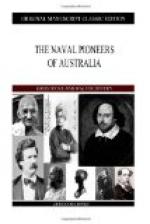[Illustration: ENGAGEMENT BETWEEN THE CREW OF THE WAAKSAMHEYD TRANSPORT AND THE NATIVES OF AN ISLAND NEAR MINDANAO. CAPTAIN HUNTER, R.N. From the “Naval Chronicle” for 1801. To face p. 102.]
In the interval between Phillip’s departure for England (December, 1792) and Hunter’s arrival in the colony on September 7th, 1795, the settlement was governed successively by two lieutenant-governors. These two officers were Major Grose, the commandant of the New South Wales Corps, who ruled until December, 1794, and Captain Paterson, of the same regiment, who had charge until the arrival of Hunter. The New South Wales Corps had such an influence on the lives of these naval governors of Australia that in the next chapter it will be necessary to give a sketch of this remarkable regiment; meanwhile it may be merely mentioned that the commanding officer of the military, during the period of the four New South Wales naval governors, held a commission as lieutenant-governor, and so took command in the absence of the governor.
Upon Hunter’s arrival he did not at all like the state of affairs. Major Grose had permitted to grow up a system of trade in which his officers had secured monopolies, and, as a leading article of this commerce was rum, it can easily be understood in what a state of disorder Hunter found the colony. Instead of the prisoners being kept at work cultivating the ground, the officers of the New South Wales Regiment employed more than a proper proportion of them in their private affairs; and the consequence was, the settlement had made little or no progress on the road to independence—that is, of course, independence in the matter of growing its food supply, not its politics. Further than this, Grose’s methods of governing a colony and administering its laws were the same as those he employed in commanding his regiment. He was not able to rise above this; and under him martial law was practically, if not nominally, the form of the colony’s government. Paterson, his successor, passively carried on until the arrival of Hunter the same lines as his predecessor; and the consequence was, the colony existed for the benefit of the officers of the regiment, who, by huckstering in stores, were rapidly acquiring fortunes. A few free settlers had already arrived in the colony, and by degrees emancipated prisoners and emigrants from Great Britain were forming a small free population, and were beginning to have “interests.” Thus there were slowly growing the elements of a pretty quarrel, a triangular duel, in which officials, free emigrants, and emancipated convicts had all interests to serve, and which for many long years after was the constant bugbear of the governor of the colony.
By the time Hunter arrived there were a number of time-expired prisoners in the settlement, and these became an increasing and constant danger. Retreating into the back country, and herding with the blacks, or thieving from the farmers, they merged into what were known later on as bushrangers. From these men and the ill-disciplined and gaol-bird soldiers of the New South Wales Corps the peaceably disposed inhabitants were in much greater danger than they ever were from the aborigines.




